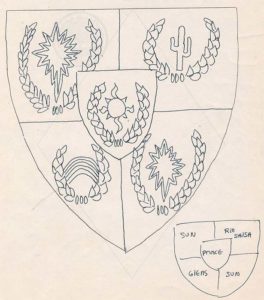Quartering is the practice of displaying two or more arms on a single escutcheon, each inherited by the individual bearer from their parents. The display of each quarter is a testament to the value of that armorial bearing. Consider the arms of Queen Elizabeth II, who (like her predecessors) displays the quartered arms of the England, Scotland, and Ireland. While Her Majesty has many other bearings and titles to her name, these are considered the most prestigious and important of her armorial holdings.
 In looking at more complex armorial bearings (e.g. the arms of Charles I of Spain), it occurred to me that a Grand Quartering of the kingdoms of the SCA would be an interesting exercise. This interest was compounded when I found this page in the Laurel archives, labeled “Proposed Marshalling of the Arms of the Provinces of the Principality [of Atenveldt] with the Arms of the Crown Prince,” dated February 1972.
In looking at more complex armorial bearings (e.g. the arms of Charles I of Spain), it occurred to me that a Grand Quartering of the kingdoms of the SCA would be an interesting exercise. This interest was compounded when I found this page in the Laurel archives, labeled “Proposed Marshalling of the Arms of the Provinces of the Principality [of Atenveldt] with the Arms of the Crown Prince,” dated February 1972.
So without further ado, here is the progression of quartering the kingdom armorial holdings of the Society for Creative Anachronism.
| 1967 – The Kingdom of the West |
 |
| 1968 – The Kingdom of the East. quartered with the West. The arms of both kingdoms are doubled to fill the available space. This is common in quarterings of two pieces of armory. |
 |
| 1969 – The Kingdom of the Middle, quartered with the West and East. The arms of the Middle are placed in the third quadrant, replacing the previously duplicated arms of the East, with the arms of the West still duplicated in the fourth quarter. |
 |
| 1971 – The Kingdom of Atenveldt, quartered with the West, East, and Middle. Though Atenveldt split off from the West, it is treated in this project as a kingdom of equal standing with the first three for reasons that will become apparent further down. |
 |
| 1978 – The Kingdom of Meridies, quartered with Atenveldt. This is the first definitive time an established kingdom had another kingdom break away from it. Accordingly, the fourth quarter is itself quartered. |
 |
| 1978 – The Kingdom of Caid, quartered with the West. |
 |
| 1979 – The Kingdom of Ansteorra, quartered with Atenveldt and Meridies. |
 |
| 1981 – The Kingdom of Atlantia, quartered with the arms of the East. |
 |
| 1982 – The Kingdom An Tir, quartered with the West and Caid. |
 |
| 1984 – The Kingdom of Calontir, quartered with the Middle. At this point we have nine arms represented in sixteen quarterings. |
 |
| 1985 – The Kingdom of Trimaris, quartered with Meridies. As Trimaris broke off from Meridies, which had itself separated from Atenveldt, Meridies’ quarter is now quartered. |
 |
| 1986 – The Kingdom of the Outlands, quartered with Atenveldt, Meridies/Trimaris, and Ansteorra. |
 |
| 1993 – The Kingdom of Drachenwald, quartered with the East and Atlantia |
 |
| 1997 – The Kingdom of Artemisia, quartered with Atenveldt, Meridies/Trimaris, Ansteorra, and the Outlands. We have examples of quarterings of six in armory when an armiger holds five or six armorial holdings of equal prestige. By now, it should be obvious why Atenveldt was placed in its own quarter for this project. |
 |
| 1997 – The Kingdom of Æthelmearc, quartered with the East, Atlantia, and Drachenwald |
 |
| 1998 – The Kingdom of Ealdormere, quartered with the Middle and Calontir |
 |
| 2002 – The Kingdom of Lochac, quartered with the West, Caid, and An Tir. While portions of what became the Kingdom of Lochac were provided from Caid, the Principality owed its fealty to the West. Therefore they are treated as equivalent to Caid or An Tir. |
 |
| 2004 – The Kingdom of Northshield, quartered with the Middle, Calontir, and Ealdormere. |
 |
| 2005 – The Kingdom of Gleann Abhann, quartered with Meridies and Trimaris. |
 |
| 2015 – The Kingdom of Avacal, quartered with An Tir. |
 |
This was a fun project, and I hope that my thought processes help others in exploring this practice in their own displays.

 In looking at more complex armorial bearings (e.g. the arms of Charles I of Spain), it occurred to me that a Grand Quartering of the kingdoms of the SCA would be an interesting exercise. This interest was compounded when I found this page in the Laurel archives, labeled “Proposed Marshalling of the Arms of the Provinces of the Principality [of Atenveldt] with the Arms of the Crown Prince,” dated February 1972.
In looking at more complex armorial bearings (e.g. the arms of Charles I of Spain), it occurred to me that a Grand Quartering of the kingdoms of the SCA would be an interesting exercise. This interest was compounded when I found this page in the Laurel archives, labeled “Proposed Marshalling of the Arms of the Provinces of the Principality [of Atenveldt] with the Arms of the Crown Prince,” dated February 1972.



















